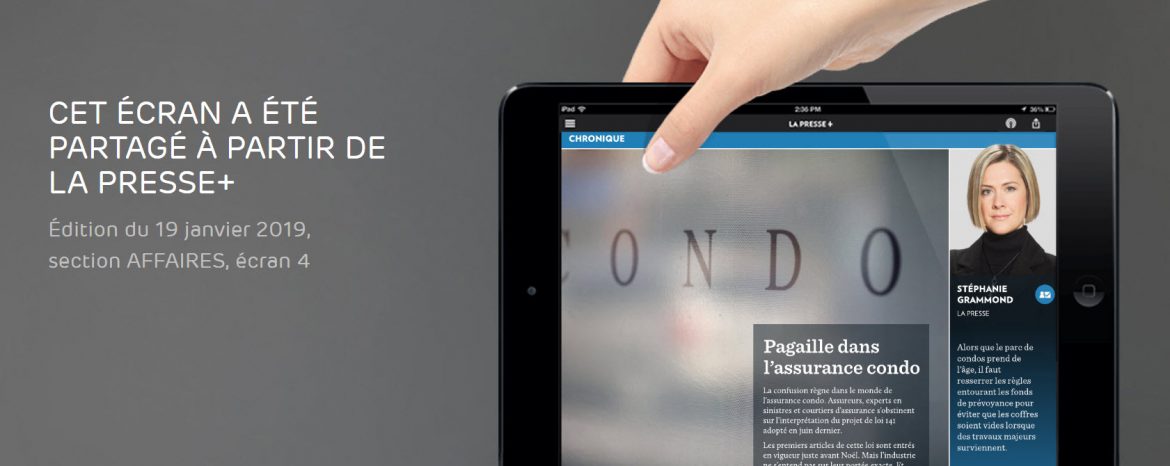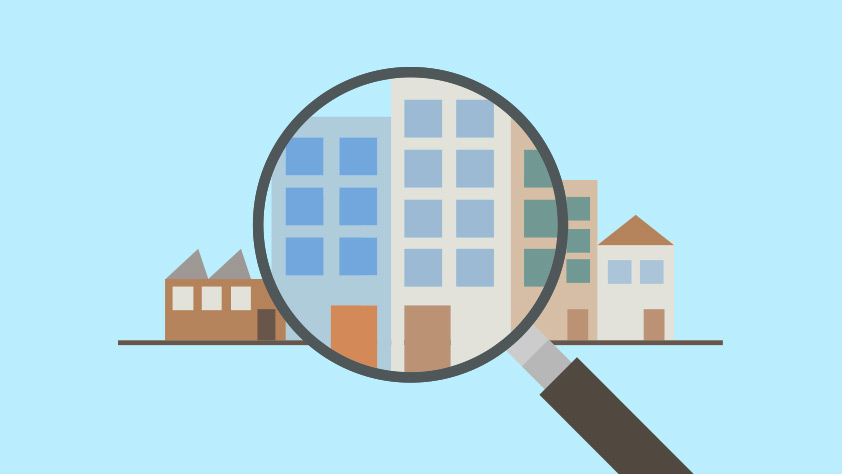CHAOS REIGNS IN THE WORLD
OF CONDO INSURANCE
Confusion is running rampant in the world of condo insurance. Insurers, claims adjusters, and insurance brokers are clashing over the interpretation of Bill 141, which was passed last June.
The first articles of this law came into effect just before Christmas. However, the industry cannot agree on their exact scope. And guess who is bearing the brunt of this chaos? That’s right—condo owners, who are completely baffled by this legal jargon.
“There is still a lot of uncertainty about the interpretation and implementation of the law,” says Lisane Blanchard, spokesperson for the Chamber of Damage Insurance (CHAD), which works to protect the public.
“There is a serious misunderstanding of the new legislative framework,” confirms Yves Joli-Coeur, a lawyer specializing in real estate law and secretary general of the Quebec Association of Condominium Managers and Owners (RGCQ). He has even written a letter to the Ministry of Finance to complain about the law’s gray areas.
Quebec needs to clarify this situation as soon as possible because some policyholders are currently left high and dry. Certain insurers—though not all—are outright refusing to compensate them.
Problematic Claims
The brokerage firm PMT Roy, which insures around 750 condominiums across Quebec, recently encountered three problematic claims in a single week.
In one case, a worn-out faucet caused $5,000 in damages. However, the condo association cannot be compensated because its insurance policy has a $25,000 deductible, which is not uncommon. Due to the surge in water damage claims in recent years, some insurers have raised deductibles to as much as $100,000.
The insurer of the affected condo owner is also refusing to pay, interpreting the new law to its advantage. “They’re saying the condo association will have to handle the repairs themselves and pay out of pocket,” reports Annie Gosselin, a commercial damage insurance broker at PMT Roy.
This is bound to spark conflict. If condo associations have to pay for every incident below the deductible, condo owners will face hefty special assessments. They are likely to be furious with their negligent neighbors.
“Why should I pay for them?” they’ll say. “I replaced my water heater! My faucets are in good condition!” A perfect recipe for neighborly disputes.
“If some insurers continue with this approach, condo owners will stop replacing their plumbing fixtures and maintaining their private units, knowing that the condo association will foot the bill every time. That’s not reasonable,” says Gosselin.
Setting the Record Straight
Since 1994, condo associations have been required to insure all common and private areas of the building, explains Joli-Coeur. However, most condo declarations require owners to carry liability insurance to cover the condo association’s deductible. This obligation will soon become law.
Under the new law, condo associations will no longer be required to file a claim with their insurer for every incident, which could be disadvantageous when damages slightly exceed the deductible.
Whether or not a claim is filed, the condo association will still be obligated to carry out repairs. However, it will never be able to claim more than the deductible amount from the at-fault condo owner. The term “at-fault” is currently causing some strange interpretations.
Additionally, condo owners must also insure their personal belongings and any improvements made to their unit. This is logical: why should the condo association’s insurance pay for exotic hardwood floors or marble countertops installed by an individual owner?
To help condo owners better identify and assess the value of improvements made over the years, the law will require condo associations to prepare a sufficiently detailed description of the base unit. However, the exact format of this document remains unclear.
If condo associations fail to comply, the entire building will be presumed to have no modifications, meaning it will be fully insurable by the condo association. While this part of the law is not yet in effect (except for buildings constructed after June 13, 2018), “insurers are already applying it as if it were, leading to claims adjusters saying all sorts of things,” laments Joli-Coeur.
A Broader Reform is Needed
The adoption of Bill 141 is just one piece of the puzzle in the broader reform of condo law.
The other piece was Bill 401, introduced by Liberal Minister Lise Thériault last June. Unfortunately, the bill died on the order paper, and it remains to be seen whether the Coalition Avenir Québec will have the motivation to pick up where it left off.
This reform is essential. The rules governing condominiums will turn 50 this year. They’re far from modern.
In 1969, condos were a marginal phenomenon. Today, the issue affects a significant portion of the population. In Quebec, more than 413,000 households live in condominiums, representing nearly 12% of all households, according to Statistics Canada. The percentage is even higher in Montreal, where nearly one in five households (18.5%) lives in a condo.
It’s high time to clean up these outdated rules.
As the condo stock ages, stricter rules are needed for reserve funds to ensure there is money available when major repairs are required.
And now that we have massive buildings with hundreds of condo units, we need to ensure that managers are professionals with the necessary skills to navigate this complex world.
STÉPHANIE GRAMMOND
LA PRESSE
Voir nos autres articles

Column on the chaos in condo insurance
CHAOS REIGNS IN THE WORLD OF CONDO INSURANCE Confusion is running rampant in the world of condo insurance. Insurers, claims adjusters, and insurance brokers

Condo and Water Damage
Condo and Water Damage Water damage is a real headache. For the past 10 years, it has been the leading cause of home insurance claims

In a Condo, Who Pays for Water Damage?
In a Condo, Who Pays for Water Damage? In condominiums, water damage often has serious consequences. Imagine a water heater leaking or a washing machine

Frequently Asked Questions
Frequently Asked Questions I want to change or add information to my profile on the Akicentral platform. How do I proceed? Please send the following

UNIONS OF CONDOMINIUMS IN THE SPOTLIGHT OF INSURERS
UNIONS OF CONDOMINIUMS IN THE SPOTLIGHT OF INSURERS «Insurers tighten rules for condominiums », headlined an article in Condoliaison published in autumn 2009. A year




